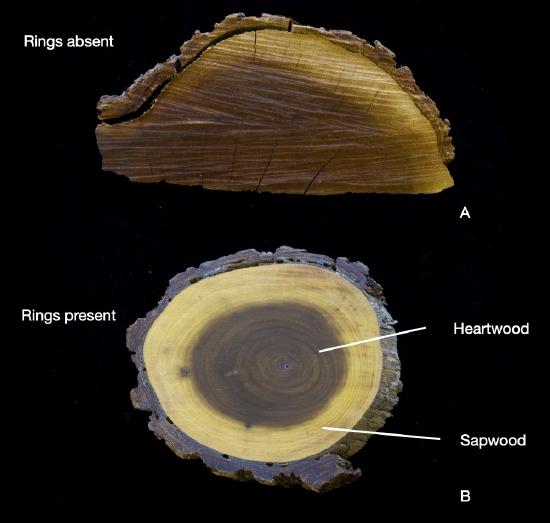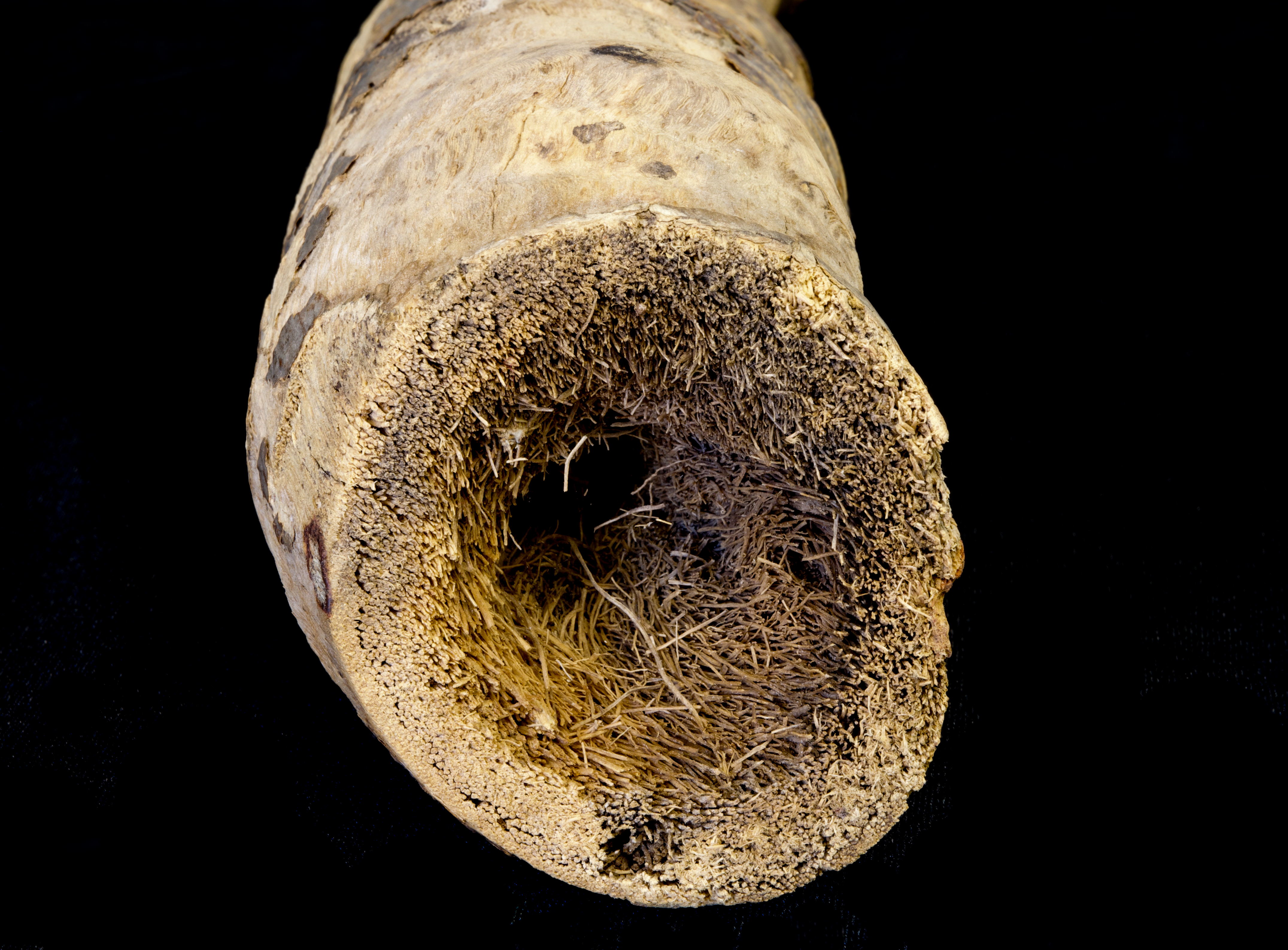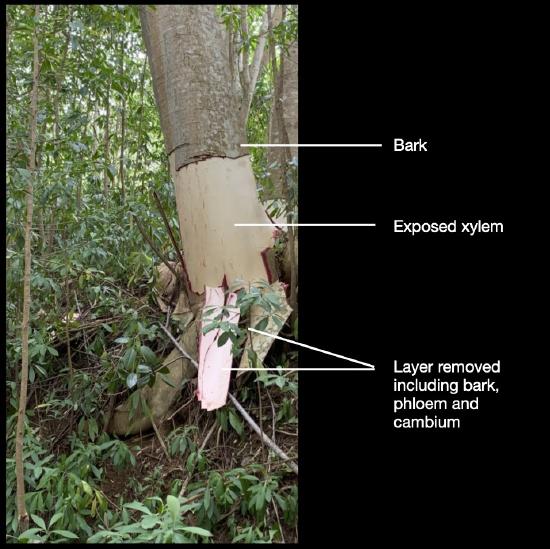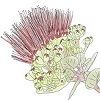3.2: Secondary growth
- Page ID
- 59225
Besides growing vertically, some plants also have secondary growth, meaning they also grow in diameter. This is especially true for plants that grow for several growing seasons (perennial), like woody plants (i.e. eudicots and gymnosperms). Herbaceous plants, like monocots and herbaceous eudicots, only grow for one growing season (annuals) and they do not present secondary growth. The tissues in woody stems, starting from the outer layer are bark, vascular cambium, sapwood, and heartwood (Figure \(\PageIndex{1}\)). The bark consists of cork, cork cambium, and phloem. The vascular cambium is a layer of meristematic tissue that produces secondary xylem to the inside and phloem to the outside. This is the reason why woody plants can grow in diameter.
The tissue responsible for the secondary growth in woody stems is the vascular cambium. Vascular cambium is found in between the xylem and phloem in woody stems, it produces xylem to the inside of the stem and phloem to the outside of the stem. Because we are considering the secondary growth, we refer to the xylem produced by the vascular cambium as secondary xylem (wood). As the secondary xylem accumulates from one growing season to the next, the stem grows in diameter (this is called girth). In temperate climates plants grow according to the seasons, growing mainly during the spring and summer, resulting in clearly defined growth rings visible on woody stems (Figure \(\PageIndex{2}\)). These growth rings provide information about the age of the tree, as usually, one growing season represents one year. Each ring consists of an area of light-colored wood (spring wood) that is formed during the spring when water is readily available for plant growth, and an area of dark wood (summer wood) that is formed late in the growing season when water availability is starting to decrease. Springwood consists of xylem cells that are larger in diameter (vessel elements), while the xylem cells in summer wood are smaller in diameter. The amount of water available during the growing season is correlated to the amount of spring wood produced in each ring; therefore, growth rings also provide insights into the climatic conditions prevalent during the growing season. For example, a thicker growth ring indicates a year with more precipitation/water availability than a thinner growth ring.

Xylem in woody stems is what is called wood, and its main function is to transport water and nutrients. Functioning xylem (sapwood) is lighter in color and is found closest to the vascular cambium. Older xylem (heartwood) can be recognized because of its darker color, and it is found towards the center of the stem (Figure 5). This older xylem is no longer functional, however both sapwood and heartwood provide mechanical support for the plant. Many trees are able to survive and function normally after losing the heartwood, either to rotting or fire, as in the case of giant sequoias. Some trees in the tropics never stop growing because they may exist in a place without well-developed seasons. In this case, the tree may not produce rings (Figure \(\PageIndex{3}\)).

Wood or not wood?
It is important to note that not all woody stems are the same. The wood that is produced by eudicots is commonly called hardwood, while the wood produced by conifers, like pine trees is called softwood. The main difference between the wood from these two groups of plants is that wood from eudicots is composed of cells called vessel elements, fibers, and tracheids, while in conifers the wood is composed only of cells called tracheids. Other plants, like coconut or hala (Pandanus sp., Figure \(\PageIndex{4}\)), appear woody but they are not. Monocots are unable to produce wood, so they are mostly herbaceous, but that does not mean some species cannot grow tall. Some monocots can grow long stems by having thicker parenchyma cells in between the scattered vascular bundles (e.g. coconut and hala), and other monocots have overlapping leaves with thick petioles wrapped around the stem that provide mechanical support (e.g. some palm trees), and other monocots have prop roots to increase the mechanical support of the stem (e.g. hala).

Putting this knowledge into practice: How to kill an invasive tree
Invasive plant species in Hawai‘i can be very problematic. Not only do they displace native species, but they can also cause damage to property and roads. Plants like albizia (Falcataria moluccana) grow really fast and are susceptible to falling during strong winds. One strategy that arborists use to kill albizia is a technique called girdling (Figure \(\PageIndex{5}\)), where the outer layer of the stem is removed all the way around and the tree is left standing. Eventually, the tree dies, because as the outer layer is removed, the phloem and the cambium are removed from the tree. The tree is still able to photosynthesize, but the sugars coming from above the girdled region cannot reach the roots to feed the cells there, therefore the plant eventually starves to death. Since the cambium is also removed, the tree cannot produce new phloem. The only thing the tree is left with is the xylem, so it is still able to transport water up the stem. The tree can survive like this for several months, but it will eventually die. A standing dead tree can be dangerous since it will drop branches and can damage structures and harm people. Tree killing and removal should be done by professional arborists so that accidents don’t happen.



